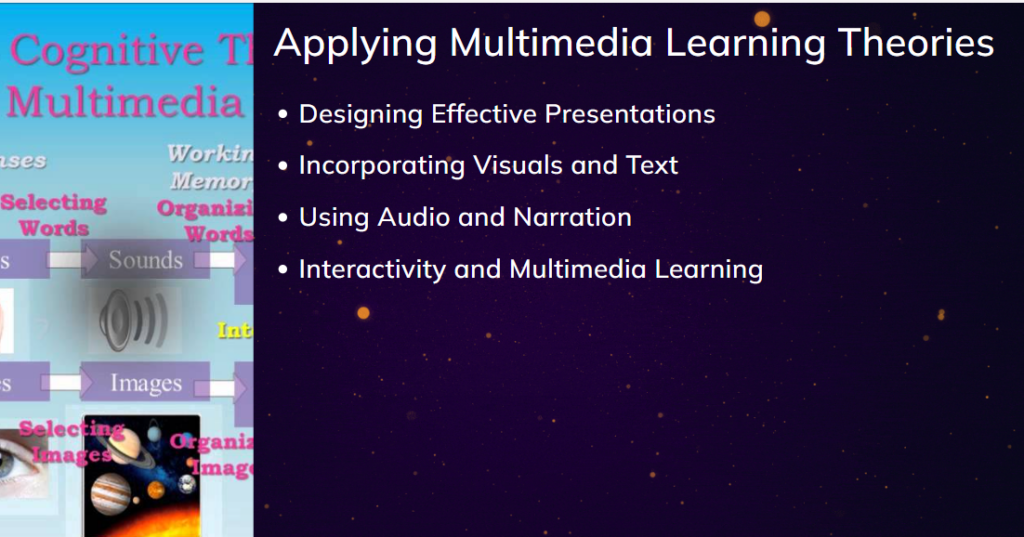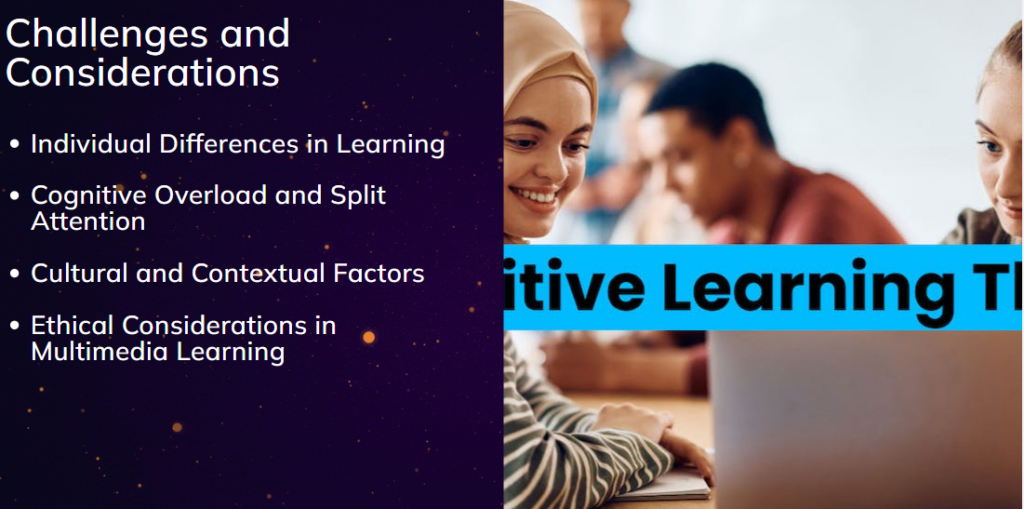In today’s digital age, my approach to knowledge has changed dramatically. The point of multimedia learning theory is that I need to understand how different media affect my acquisition and retention of information. In this first blog entry, I will delve into Module 1 of my teaching course, “The Mechanisms of Learning”. The purpose of this paper is to explore the theoretical foundations of multimedia learning, with a focus on key concepts that contribute to my understanding of this field.
Why multimedia learning theory matters Effective communication is an important skill in my line of work. Years of research have consistently shown that the principles outlined in this course have a profound effect on my recall, engagement, and retention. These principles play an important role in creating meaningful learning experiences for me. In this course, I will explore these concepts more closely as I explore techniques such as Design Thinking, Active Learning, and Storytelling.
Foundations of multimedia learning The main focus of this introduction is the theoretical foundation underlying Meyer’s Cognitive Theory of Multimedia Learning (CTML). This theoretical framework aims to reduce cognitive overload and resolve implicit cognitive load in multimedia-based learning.
Here are the key learning outcomes for this module:
Cognitive Load Theory
- I will describe the basic components of Cognitive Load Theory.
Dual Coding Theory
- I will explain Paivio’s Dual Coding Theory and its significance in learning design.
Types of Cognitive Load
- I will define intrinsic, extraneous, and germane cognitive load.
Cognitive Learning Theories
- I will identify the cognitive learning theories that underlie Mayer’s CTML.
Core Principles of CTML
- I will describe the core principles of CTML designed to reduce extraneous cognitive load, manage intrinsic load, and maximize germane load.
Applying Principles
I will apply the core principles of Mayer’s CTML to design a PowerPoint presentation using Canva, sharing my first experience.

Exploring the Theories
Throughout this module, I have various resources to aid my understanding of these theories. Quick videos introduce Cognitive Load Theory, which can be especially helpful if I’m not from the Faculty of Education. The Dual Coding Theory Overview provides insights into Allan Paivio’s dual coding theory, while the Principles of Multimedia Learning offers practical suggestions for applying Robert Mayer’s principles in multimedia learning object creation. Short videos dive into Mayer’s principles, covering redundancy, coherence, signaling, contiguity, segmenting, pretraining, and modality. Effective Educational Video explores the application of Mayer’s principles in creating effective educational videos.
Managing Cognitive Load
One of the central themes of this module is cognitive load management. Mayer’s CTML is built on three cognitive science principles:
Limited Capacity (Cognitive Load Theory): I will explore Sweller’s Cognitive Load Theory, which highlights the limited capacity of different memory systems.
Dual Coding Theory: I will delve into Paivio’s theory, which suggests our brains process language and images separately, allowing for simultaneous information processing.
Active Processing: I will examine Mayer’s Active Processing theory, which posits that we construct mental representations through active processes like filtering, selecting, organizing, and integrating information.
Cognitive Load Types
I will also explore how these principles apply to diff erent types of cognitive load:
- Extraneous Cognitive Load is caused by poor design and includes unnecessary elements that distract from learning. Mayer’s principles, such as redundancy, coherence, signaling, and contiguity, help reduce extraneous load.
- Intrinsic Cognitive Load is related to the difficulty of the learning task itself. Principles like segmenting, pretraining, and modality assist in managing intrinsic load.
- Mayer’s Cognitive Theory also considers the impact of social cues, such as personalization, voice, and image, on managing cognitive load and promoting effective learning.

Screencasting Exploration
I chose to create a screencast using a PowerPoint presentation to explain a complex concept.
During the creation of the screencast, I was able to reflect on the core principles of Mayer’s CTML, which I had learned earlier in the course. I focused on reducing extraneous cognitive load by eliminating any unnecessary elements that could distract from the main message. I also aimed to manage the intrinsic cognitive load by breaking down complex concepts into smaller, more digestible segments.
Planning and Content Creation
Creating Slides
Visual Design
Editing and Refinement
These are the steps that I have followed while screencasting through PowerPoint.
Using PowerPoint for screencasting provided me with a user-friendly and accessible platform to create content. It allowed me to combine visual elements with narration, making the content both informative and visually engaging.
Reflection Questions
To conclude this module, I reflect on my experiences and understanding:
Which of the tenets of the Cognitive Theory of Multimedia Learning most appealed to you? Were there any that caught you off guard?
“Signaling” was the idea that I connected with the most. I thought it was really good at bringing the viewer’s focus to the important details. How such a basic visual cue may improve comprehension of the information shocked me.
How did you put these ideas into practice when you made your screencast? Which principles created difficulties for you to implement, and which did not?
In my screencast, I applied various principles. Integrating coherence and signaling was not
Intrinsic Cognitive Load is related to the difficulty of the learning task itself. Principles like segmenting, pretraining, and modality assist in managing intrinsic load.
Mayer’s Cognitive Theory also considers the impact of social cues, such as personalization, voice, and image, on managing cognitive load and promoting effective learning.
too difficult. I made sure the information made sense and used distinct visual cues to draw attention to crucial details. The idea of “redundancy” posed a problem, though. Finding the ideal mix between reiterating material and avoiding monotonously boring the viewers was difficult for me.
When creating your screencast, did you keep your intended audience in mind? How did your design decisions differ depending on the target audience?
Yes, I took into account my intended audience when creating my screencast. I tried to strike a balance between giving adequate information for beginners and providing deeper insights for those who were more experienced about the topic because I was aware that my audience had varied levels of prior knowledge on the issue. This affected the level of detail and the flow of the presentation, which in turn affected my design decisions.
Give an example of a multimedia learning concept you have previously instinctively followed and one you haven’t. Based on what you’ve learned, what will you change?
I naturally adhered to the multimedia learning principle of keeping my presentations organized and aesthetically pleasing. I had not, however, given any thought to the notion of “segmenting.” Based on what I’ve learned, I’ll try to simplify complex subjects into smaller, easier-to-understand chunks to increase audience comprehension and retention. This strategy follows the guidelines for controlling intrinsic cognitive stress.
Conclusion
Module 1 sets the foundation for our exploration of multimedia learning theories. As we progress through the course, we will continue to build on these principles to create effective and engaging learning experiences. Stay tuned for more insights and practical applications in multimedia learning!
Leave a Reply
You must be logged in to post a comment.